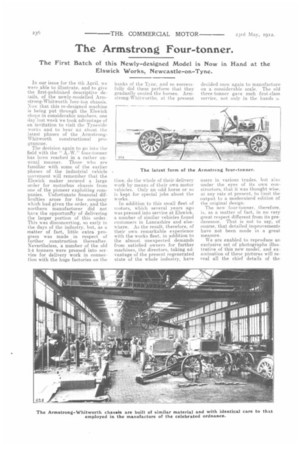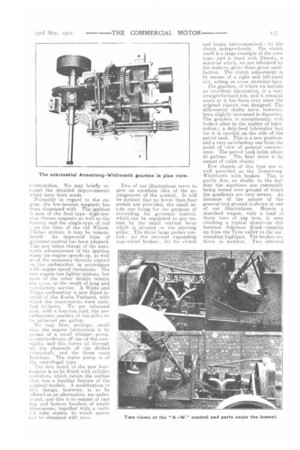The Armstrong Four.tonner.
Page 6

Page 7

Page 8

If you've noticed an error in this article please click here to report it so we can fix it.
The First Batch of this Newly-designed Model is Now in Hand at the Elswick Works, Newcastle-on-Tyne.
In our issue for the 4th April, we were able to illustrate, and to give the first-published descriptive details, of the newly-modelled Armstrong-Whitworth four-ton chassis. Now that this re-designed machine is being put through the Elswick shops in considerable numbers, one day last week we took advantage of an invitation to visit the Tyneside works and to hear an about the latest phases of the ArmstrongWhitworth constructional programme.
The decision again to go into the
field with the " four-tonner has been reached in a rather unusual manner. Those who are familiar with some of the earlier phases of the industrial vehicle movement will remember that the Elswick maker secured a large order for motorbus chassis from one of the pioneer exploiting companies. Unfortunate financial difficulties arose for the company which had given the order, and the northern manufacturer did not have the opportunity of delivering the larger portion of this order. This was disconcerting, so early in the days of the industry, but, as a matter of fact, little extra progress was made in respect of further construction thereafter. Nevertheless, a number of the old 3-4 tanners were pressed into service for delivery work in connection with the huge factories on the
banks of the Tyne, and so successfully did these perform that they gradually ousted the horses. Armstrong-Whitworths, at the present time, do the whole of their delivery work by means of their own motor vehicles, Only an odd horse or so is kept for special jobs about the works.
In addition to this small fleet of motors, which several years ago was pressed into service at Elswick, a number of similar vehicles found customers in Lancashire and elsewhere. As the result, therefore, of their own remarkable experience with the works fleet. in addition to the almost unexpected demands from satisfied owners for further machines, the directors, taking advantage of the present regenerated state of the whole industry, have decided once again to manufacture on a considerable scale. The old three-tonner gave such first-class. service, not only in the hands
users in various trades, but also under the eyes of its own constructors, that it was thought wise,. at any rate at present., to limit the output to a modernised edition of the original design.
The new four-tonner, the is, as a matter of fact, in no very great respect different from its predecessor. That is not to say, of course, that detailed improvements have not been made in a great measure.
We are enabled to reproduce an exclusive set of photographs illustrative of this new model, and examination of these pictures will reveal all the chief details of the
construction. We may briefly recount the detailed improvements .which have been made.
Primarily in regard to the engine, the low-tension magneto has been dispensed with. The ignition is now of the dual type—high-tension Simms magneto as well as the battery and the single-type of coil -on the lines of the old WilsonPitcher system, it may be remembered. An improved form of governor control has been adopted. This iow takes charge of the automatic advancement of the ignition when the engine speeds up, as well as of the necessary throttle control iii the carburetter, in accordance with engine-spee.d variations. The new engine has lighter pistons, but most of the other details remain the slaw, as the result of long and satisfactory service. A White and Popre carburetter is now fitted instead of the Krebs Panhard, with which the constructors were satisfied hitherto. We are informed that, with a four-ton load, the new carburetter enables 48 ton-miles to he achieved per gallon, We may here, perhaps. recall that the engine lubrication is by means of a small plunger pump. eccentric-driven off one of the cantshalt s. and this forces oil through all the channels of the drilled crankshaft, and the three main bearings. The water pump is of the centrifugal type.
The first batch of the new foot.tonners is to be fitted with cellular radiators, which retain the outline that was a familiar feature of the uriginal models. A modification to this design, however, is to be offered as an alternative, we understand, and this is to consist of cast top and bottom headers of ample dimensions, together with a vertieal tube centre, to which access can be obtained with ease. Two of our illustrations serve to give an excellent idea of the arrangement of the control. It will be noticed that no fewer than four pedals are provided, the small JR6.:cie one being for the purpose of overriding the governor control, which can be regulated to any extent by the small vertical lever which is pivoted on the steering pillar. The three large pedals control : (a) the internal expanding rear-u heel brakes ; (b) the clutch and brake interconnected; (e) the clutch independently. The clutch itself is a large example of the cone type, and is lined with Ferodo, material which, we are informed by the makers, gives them great satisfaction. The clutch adjustment is by means of aright and left-hand nut, acting on cross stretcher-bars. The gearbox, of which we include an excellent illustration, is a very straightforward job, and it remains much as it has been ever since the original chassis was designed. The differential shafts have, however, been slightly increased in diameter. The gearbox is exceptionally well looked after in the matter of lubrication ; a drip-feed lubricator box for it is carried on the side of the petrol tank. This is a new position, and a very satisfactory one from the point of view of general convenience. The petrol tank holds about. 25 gallons. The final drive is by means of roller chains.
Few chassis of this type are so well provided as the ArmstrongWhitworth with brakes. This is partly due, no doubt, to the factthat the machines are constantly being tested over ground of which the gradients are very severe. An instance of the nature of the general test ground is shown in one of our illustrations, Herein a standard wagon, with a load of three tons of pig iron, is seen climbing a typical street—in this instance Atkinson Road—running up from the Tyne valley to the surrounding highland. The brakes are three in number. Two internal
expanding brakes act on the road e-heels. There is a large cast-iron brake on the countershaft, and ngain a powerful cast-iron brake
acting on the main body of the differential. Tests up and down some of the Tyneside street6 revealed a positively remarkable beaking outfit on the new wagon. Any one of the brakes was sufficient to pull the machine up, when going full-speed downhill, within a very short distance. Their cumulative effect was remarkable.
The resources of Armstrong-Whitworths require no fresh record here. This manufacturer has a reputation which is world-wide in the • matter of ordnance and war material of all kinds. The industrial-vehicle side of the business at present is, of course, a small portion of the organization at Tyneside. The pleasure-car factory at Scotswood has already outgrown its short clothes, and is a prosper ous centre. The industrial-vehicle section is at present labouring under the disadvantage of the separate manufacture of corn ponents in various ordnance and other shops, whilst the headquarters, under Mr. Engelbach, are at Scotswood. It is hoped before long to amalgamate the various commercial-vehicle sections.
As to the grade of workmanship and the quality of the material, there need not be the slightest doubt that these are both of the finest available, and to these considerations are principally due the long and satisfactory service which the original models have achieved, by which the makers have practically been forced once again to take up the manufacture. Altogether there must be something like 90 Armstrong-Whitworth lorries on the road, and it is interesting to know that practically the whole of the modifications for the new ma
chine are interchangeable on theold one. The renewed demand for these straightforward models leads one to suppose that it will not be• long before the gearbox is ceased. to be manufactured in shops where also the racks for turret mountings are being cut on huge horizontal millers. and the axles and other forgings will not rub sides with hugeframe members for ship structures. At present the chassis are being erected in one of the small ordnance shops. One of our illustrations shows this juxtaposition of products in a picturesque manner.
We do not think there could be better augury of high-class workmanship and care lavished on the production of the machine than the fact that temporarily the men who are making the guns are also making the chassis. Armstrongs' renewed activities in the industrialvehicle world cannot be but for theadvantage of the industry at large.






















